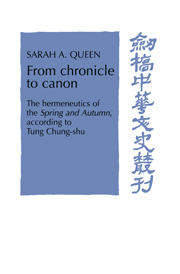Book contents
- Frontmatter
- Contents
- List of tables
- Acknowledgments
- List of abbreviations
- 1 Introduction
- PART I Three perspectives on the authenticity of the Ch'un-ch'iu fan-lu
- PART II Exegesis and canonization
- 5 The Spring and Autumn and Kung-yang tradition
- 6 Reforming the Ch'in laws
- 7 The wider circle of Han jurisprudence
- 8 Refashioning the imperial rites
- 9 Canon, cosmos, and court patronage
- 10 Conclusion
- Appendix 1 The birth and death dates of Tung Chung-shu
- Appendix 2 The dates of the Han-shu 56 memorials
- Appendix 3 Han transmission of Kung-yang learning
- Appendix 4 Han dynasty disciples of Tung Chung-shu
- Appendix 5 Citations and titles attributed to Tung Chung-shu
- Appendix 6 Transmission of Ch'un-ch'iu fan-lu editions
- Selected bibliography
- Index
9 - Canon, cosmos, and court patronage
Published online by Cambridge University Press: 10 December 2009
- Frontmatter
- Contents
- List of tables
- Acknowledgments
- List of abbreviations
- 1 Introduction
- PART I Three perspectives on the authenticity of the Ch'un-ch'iu fan-lu
- PART II Exegesis and canonization
- 5 The Spring and Autumn and Kung-yang tradition
- 6 Reforming the Ch'in laws
- 7 The wider circle of Han jurisprudence
- 8 Refashioning the imperial rites
- 9 Canon, cosmos, and court patronage
- 10 Conclusion
- Appendix 1 The birth and death dates of Tung Chung-shu
- Appendix 2 The dates of the Han-shu 56 memorials
- Appendix 3 Han transmission of Kung-yang learning
- Appendix 4 Han dynasty disciples of Tung Chung-shu
- Appendix 5 Citations and titles attributed to Tung Chung-shu
- Appendix 6 Transmission of Ch'un-ch'iu fan-lu editions
- Selected bibliography
- Index
Summary
When Tung Chung-shu's reformist goals led him to recreate the Spring and Autumn, he read a cosmology into the work. As the two preceding chapters demonstrated, he based his discussions of the legal and ritual significance of the Spring and Autumn on this cosmology. He believed that the Confucian scriptures were critical to understanding the cosmos and emulating its patterns of value. What view of the cosmos did Tung Chung-shu articulate in his exegesis of the Spring and Autumn? In Seeking to answer this question, it is helpful to rethink the interrelationship between three important aspects of Tung Chung-shu's thought as they developed within the changing political environments of both Emperor Ching's and Emperor Wu's reigns: his cosmological theories, scriptural interpretations, and political ideas. Court politics, patterns of patronage, and ideological pluralism, as well as doctrinal convictions, shaped Tung's cosmology. The following discussion moves chronologically through Tung's cosmological writings, beginning with the reliable yin–yang chapters of the Ch'un-ch'iu fan-lu, proceeding to his famous Han-shu memorials, and concluding with an analysis of Han-shu 27 (‘Treatise on the Five Phases’) and the directives he authored while serving as administrator to Chiang-tu. I use the term ‘correlative’ to refer to those aspects of Tung's cosmology that sought to align the human realm with the normative patterns of the cosmos. ‘Interactive cosmology’ is a loose rendering of the Chinese expression t'ien-jen kan-ying (the mutual responsiveness of Heaven and humanity).
- Type
- Chapter
- Information
- From Chronicle to CanonThe Hermeneutics of the Spring and Autumn according to Tung Chung-shu, pp. 206 - 226Publisher: Cambridge University PressPrint publication year: 1996



